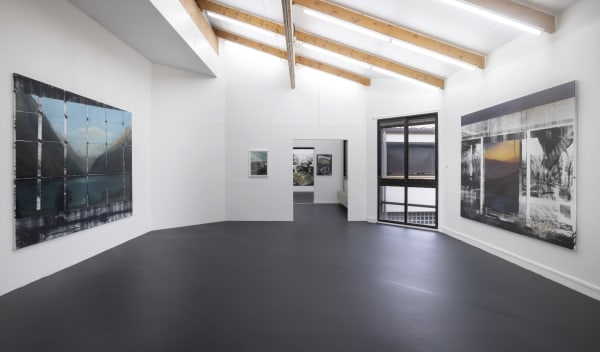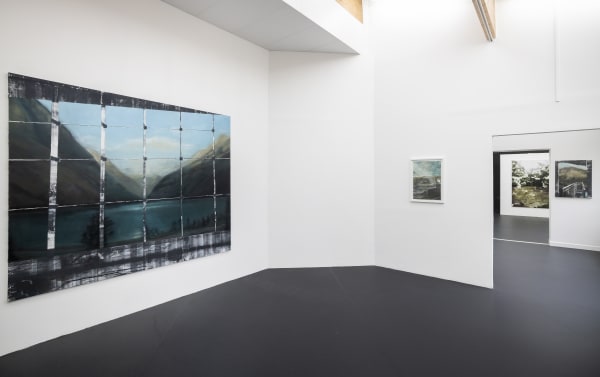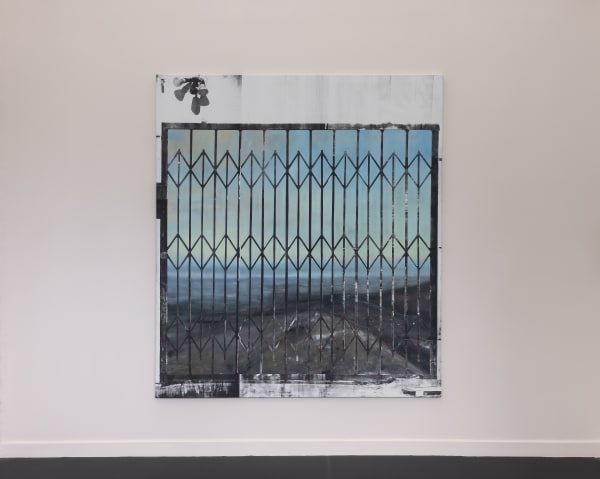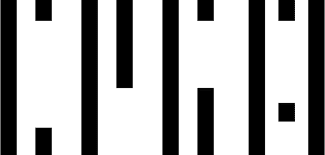Hypersurface
Le point commun, Annecy, France, 12 September - 7 November 2020
Past gallery exhibitions exhibition
Overview
The daily spectacle of the sunrise becomes exceptional and striking. Being alive or an artist is surely that. Seize things when they present themselves to us and amplify them to scale 1. Eva Nielsen works to capture these micro-events, to better grasp the essentiality of the moment, during our short and presumptuous passage on earth. The silkscreen act of the artist comes to signify an architecture, a layout, a vestige. These urban landscapes composed of concrete monuments, or metallic structures signify our presence. We are overwhelmed. The enveloping force of nature mixed with pictorial virtuosity takes precedence. Eva Nielsen's urban and naturalistic peregrinations question and reorganize our visions, our appreciations of the world. The landscape is transformed into a contemporary totemic sign. Eva Nielsen offers us a leap into the landscape. From an architectonics printed insfumato of an oil painting, we are invited to look at time and space in the photographic room. Eva Nielsen holds the black cloth so that the reverse image can be seen. The one that will become painting. To trace a mental landscape with lines, to cover it, to outline it and to try to reach the good pictorial equation, which will make work.
Eva Nielsen's spaces leave a spiritual and visual breach to the viewer: a crack in the concrete, a perforated mosquito net, a raised oak slat. Witnesses of a static and meditative time, we welcome behind the discreet moucharabieh, an intriguing and staggering non-event. The artist leaves us a place at his side, to witness the captured moment. The one, so long sought after, the one that can become painting. The artist forces the gaze and reality is irradiated.
Eva Nielsen's painting seems to hesitate between deafening calm and explosive derailment. Looking closely at his canvases, one easily visualizes his agitation in the studio, no doubt animated by contradictory gestures. We imagine him cutting hastily, printing meticulously, erasing fully, mopping up abruptly, reversing silently, all of this in a worried and pleasurable urgency. Her serigraphs with folded curtains, such as Lucite,give the sensation of a three-dimensional canvas that would be abused by dint of folding and says it all about the impossible objective of painting and its necessary twist to renew itself. His paintings recall distant memories of experimental films where the image derails, trips, opens and closes, is burned by the film, then scratched, lacerated, cut off too soon, when the scrolling speed is suddenly upset. .
During a discussion in our studio at the Beaux-Arts, Eva evokes the reading of The Secret History by Donna Tartt. Obvious links are then woven between this book which interweaves forms of thriller, thriller, psychological drama and the combinatorial painting of Eva Nielsen. We find there an agility in the games of collage, assembly and grafting that undermine the evidence of the image and its understanding. The statutory landscape is altered, disrupted, sometimes even overturned by devices that come from printing, manual gestures or natural elements (rain, mould). An intrigue settles between the viewer and the work.
Donna Tartt's Vermont landscape resonates with Eva Nielsen's vaporous granitic mountains given to us in a distant quiver. They lead us into a vertigo of grandiose landscapes where the smells, lights and shadows of a nature that plays a major role intermingle. There is a strong seasonal rhythm: a severe winter in the Aklat series or a muddy autumn in Templateuntil the spring intermission in certain curtains. The variations of light and color are brought into tension by the use of serigraphy of architectural elements or manufactured objects. Eva Nielsen diverts this tool to create an accidental and fragile power. In his painting, the screen-printed parts then appear to us as troubled areas, blind spots, flashes, glare, accidents. The mountains, the meadows, the lakes become the receptacle of a gesture which escapes us – and which partly escapes the author. This is the challenge of painting. A balancing act between a complex work of composition and the randomness of the medium. It is to allow letting go.
There is always something that derails, that blurs, that interferes with the eye of the viewer. And eye it is eminently question in his work. The circular, orbital shape is recurrent. The framings are tightened on circular geometric elements – holes, breakthroughs, eye, blindness? What can be seen are landscapes, distant, in front of which appear almost abstract architectural forms which, always frontal, impose themselves and simultaneously escape the gaze. The reason why "it holds" is this tension, in each canvas, between these two opposing impulses. The screen-printed architectural elements – micro or macro – contain in their very manufacture accidents and chances generated by the superposition and shifts of the screens that compose them.
What one feels in the work of Eva Nielsen, as a painter, is the pure pleasure of painting. After the long stages of composition (photographic collages, montages, disturbances of scales…) it is painting itself that takes precedence. The gesture, whether silkscreen, printing, or purely pictorial, imposes itself and reveals itself. The excitement is perceptible in the process itself, when the masking tape is removed from the silkscreen, when the print comes to cover a background, brushed, in ink, when the oil paint emerges in front of / behind the black and white and the reserve of the serigraphy. The game is palpable, even if the term does not evacuate the difficulty renewed each time, even the failure (where the painting can then fall) just like the necessity and the impulse which lead to the painting,
Installation Views
Be the first to know updates about Galerie Peter Kilchmann
* denotes required fields
We will process the personal data you have supplied to communicate with you in accordance with our Privacy Policy. You can unsubscribe or change your preferences at any time by clicking the link in our emails.







